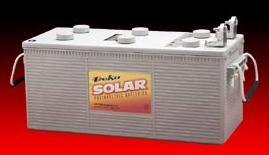
|
8G8D Deka/MK Battery Gel Cell, 12 volt 225 Amp-Hrs
|
Deka/MK Battery 8G8D Gel Cell, 12 volt 225 Amp-Hrs
MK Gel Cell Batteries Sealed Valve Regulated Gelled Electrolyte Lead-Acid Batteries (Stud terminals standard, other terminals available) Benefits Completely maintenance free. Sealed construction eliminates periodic watering, corrosive acid fumes and spills. Electrolyte will not stratify, no equalization charging required. Allows faster recharge. Increases durability and deep cycle ability for heavy demand applications. Less than 2% per month stand loss means little deterioration during transport and storage. Tank formation ensures voltage matching between cells. Batteries under 150lbs can be easily shipped by UPS, and don't require special freight truck shipping like with flooded lead acid batteries.
Applications Solar and Wind energy system Water Pumping Residential Communications Cathodic Protection Remote Monitoring Refrigeration Lighting Aids to Navigation Wheelchairs RVs Golf Carts
How does a gel cell work? A gel cell is a "recombinant" battery. This means that the oxygen that is normally produced on the positive plate in all lead-acid battery recombines with the hydrogen given off by the negative plate. The "recombination" of hydrogen and oxygen produces water (H2O), which replaces the moisture in the battery. Therefore, the battery is maintenance-free, as it never needs watering.
The oxygen is trapped in the cell by special pressurized sealing vents. It travels to the negative plate through tiny fissures or cracks in the gelled electrolyte.
The sealing vent is critical to the performance of the gel cell. The cell must maintain a positive internal pressure. Otherwise the recombination of the gasses will not take place, and the cell will dry out and not perform.
In addition, the valve must safely release any excess pressure that may be produced during overcharging. Otherwise, the cell would be irreparably damaged.
It's important to note that gel cell must never be opened. If opened, the cell loses its pressure, and the outside air will "poison" the plates and cause an imbalance that destroys the recombination chemistry.
What is the difference between gel cell and traditional wet batteries? Wet cells do not have special pressurized sealing vents, as they do not work on the recombination principle. They contain liquid electrolyte that can cause corrosion and spill if tipped or punctured. Therefore, they are not air transportable without special containers. They cannot be shipped via UPS or used near sensitive electronic equipment. The can only be installed "upright".
Wet cells lose capacity and become permanently damaged if: Left in discharged condition for any length of time (due to sulfation). This is especially true of antimony and hybrid types. Continually over-discharged, due to active material shedding. This includes specially designed deep cycle wet cells, but is especially true of automotive types. Deep cycle antimony wet cells have seven times less shelf life as well.
Deka gel cells have triple the deep cycle life of wet cell antimony alloy deep cycle batteries due to the gel cells unique design.
How do gel cells recharge? Are there any special precautions? While our gel cell will accept a charge extremely well due to its low internal resistance, any battery will be damaged by continual under- or overcharging. Capacity is reduced and life is shortened.
Overcharging is especially harmful to gel cells because of their sealed design. Overcharging dries out the electrolyte by driving the oxygen and hydrogen out o f the battery through the safety valves. Performance and life are reduced.
If a battery is continually undercharged, a power-robbing layer of sulfate will build up on the positive plate, which acts a s a barrier to electron flow. Premature plate shedding can also occur. Performance is reduced and life is shortened.
Therefore, it is critical that a charge be used that limits voltage to no more than 14.1 volts and no less than 13.8 volts at 68?F. Batteries used in float service should be charged at 13.8 volts. For deep cycle service, a maximum voltage of 14.1 volts should be used. Most of the charge controllers that we offer are compatible with gel cell type of batteries.
The charger must be temperature corrected prevent under- or overcharging due to ambient temperature changes. Most charge controllers that Affordable Solar also offer an optional temperature sensor which is placed right on one of the batteries in your battery array. Here are the ones we offer for Trace, Outback, Morningstar and SolarBoost charge controllers:
Can gel cells be installed in sealed battery boxes? NO! Never install any type of battery in a completely sealed container. Although the normal gasses (oxygen and hydrogen) produced in a gel cell battery will be recombined as described above, and not escape, oxygen and hydrogen will escape from the battery in overcharge condition (as is typical of any type of battery).
For safety's sake, these potentially explosive gasses must be allowed to vent to the atmosphere and must never be trapped in a hermetically sealed battery box or tightly enclosed space!
Note: This battery are heavy so it must ship via truck freight. Disregard shipping calculation, we will call or email with actual shipping quote.
|
Price: $528.00
Buy Product Online | Visit Store Home
|
|
|
|
|
|
|
|
Other Items from Batteries
Water Miser Safety Vent Battery Cap -
Surrette S-460 Deep Cycle Solar Battery -
Surrette 2-KS-33PS, 2 volt 1700 amp hour -
Surrette 4-CS-17PS, 4 volt 546 amp hour -
Surrette 4-KS-21PS, 4 volt 1100 amp hour -
Surrette 4-KS-25PS, 4 volt 1347 amp hours -
Surrette 6-CS-17PS, 6 volt 546 amp hour -
Surrette 6-CS-21PS, 6 volt 683 amp hours -
Surrette 6-CS-25PS, 6 volt 820 amp hour -
Surrette 8-CS-17PS, 8 volt 546 amp hour -
Surrette 8-CS-25PS, 8 volt 820 amp hour -
|
|
Return To Solar Home - Solar power products, solar lighting, solar heating, solar panels, and more!
|
|
|
|

